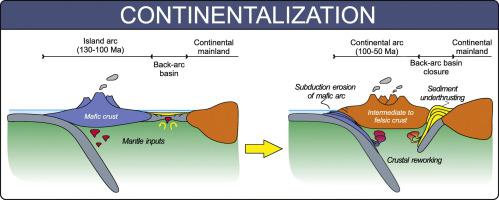当前位置:
X-MOL 学术
›
Gondwana Res.
›
论文详情
Our official English website, www.x-mol.net, welcomes your
feedback! (Note: you will need to create a separate account there.)
The origin and evolution of the Mexican Cordillera as registered in modern detrital zircons
Gondwana Research ( IF 7.2 ) Pub Date : 2020-10-01 , DOI: 10.1016/j.gr.2020.06.001 José G. Cavazos-Tovar , Arturo Gómez-Tuena , Mattia Parolari
Gondwana Research ( IF 7.2 ) Pub Date : 2020-10-01 , DOI: 10.1016/j.gr.2020.06.001 José G. Cavazos-Tovar , Arturo Gómez-Tuena , Mattia Parolari

|
Abstract Continents are thought to be built at convergent margins by mantle-derived mafic inputs, but the processes that transform them into more felsic and long-lasting constituents are still unclear. Here we use U-Pb geochronology, trace elements and Hf isotopic compositions of modern detrital zircons from western Mexico to illustrate how a typical mafic island-arc built on an oceanic basin can be rapidly transformed into a mature intermediate to felsic continent by the combined effects of subduction erosion and rear-arc sediment underthrusting, prompted by the closure of a back-arc basin. In western Mexico, the most significant mass transfer from mantle to crust occurred during the Early Cretaceous in the context of an intra-oceanic island arc, locally dubbed Alisitos-Guerrero. Subsequently, the process of “continentalization” was achieved by the deep reprocessing of the newly formed lithologies once they were dynamically incorporated into the melting source during the development of the Mexican Orogen. The Mexican continental crust did not only grow by arc-related inputs, however, as there was at least one magmatic episode in the Jurassic where extensional-driven mantle upwellings triggered melting of upper-crustal sediments. In this view, mafic island arcs and back-arc basins are ephemeral geologic features that can be easily consumed into trenches, but the geochemical evidence of their existence, and possibly even a significant portion of their mass, can be preserved in younger and more felsic continental igneous rocks.
中文翻译:

现代碎屑锆石中记录的墨西哥山脉的起源和演化
摘要 大陆被认为是由地幔衍生的镁铁质输入在会聚边缘建造的,但将它们转化为更多长英质和更持久成分的过程仍不清楚。在这里,我们使用墨西哥西部现代碎屑锆石的 U-Pb 年代学、微量元素和 Hf 同位素组成来说明建立在大洋盆地上的典型基性岛弧如何通过综合作用迅速转变为成熟的中长英质大陆由弧后盆地关闭引起的俯冲侵蚀和弧后沉积物下冲。在墨西哥西部,从地幔到地壳的最重要的质量转移发生在早白垩世期间,在一个洋内岛弧的背景下,当地称为 Alisitos-Guerrero。随后,“大陆化”的过程是通过对新形成的岩性进行深度再加工来实现的,一旦它们在墨西哥造山带的开发过程中被动态地纳入熔融源。然而,墨西哥大陆地壳不仅通过与弧相关的输入而生长,因为侏罗纪至少有一次岩浆事件,在那里伸展驱动的地幔上涌引发了上地壳沉积物的融化。在这种观点下,基性岛弧和弧后盆地是短暂的地质特征,可以很容易地消耗到海沟中,但它们存在的地球化学证据,甚至可能是它们质量的很大一部分,可以在更年轻和更长英质的岩石中保存下来。大陆火成岩。
更新日期:2020-10-01
中文翻译:

现代碎屑锆石中记录的墨西哥山脉的起源和演化
摘要 大陆被认为是由地幔衍生的镁铁质输入在会聚边缘建造的,但将它们转化为更多长英质和更持久成分的过程仍不清楚。在这里,我们使用墨西哥西部现代碎屑锆石的 U-Pb 年代学、微量元素和 Hf 同位素组成来说明建立在大洋盆地上的典型基性岛弧如何通过综合作用迅速转变为成熟的中长英质大陆由弧后盆地关闭引起的俯冲侵蚀和弧后沉积物下冲。在墨西哥西部,从地幔到地壳的最重要的质量转移发生在早白垩世期间,在一个洋内岛弧的背景下,当地称为 Alisitos-Guerrero。随后,“大陆化”的过程是通过对新形成的岩性进行深度再加工来实现的,一旦它们在墨西哥造山带的开发过程中被动态地纳入熔融源。然而,墨西哥大陆地壳不仅通过与弧相关的输入而生长,因为侏罗纪至少有一次岩浆事件,在那里伸展驱动的地幔上涌引发了上地壳沉积物的融化。在这种观点下,基性岛弧和弧后盆地是短暂的地质特征,可以很容易地消耗到海沟中,但它们存在的地球化学证据,甚至可能是它们质量的很大一部分,可以在更年轻和更长英质的岩石中保存下来。大陆火成岩。











































 京公网安备 11010802027423号
京公网安备 11010802027423号